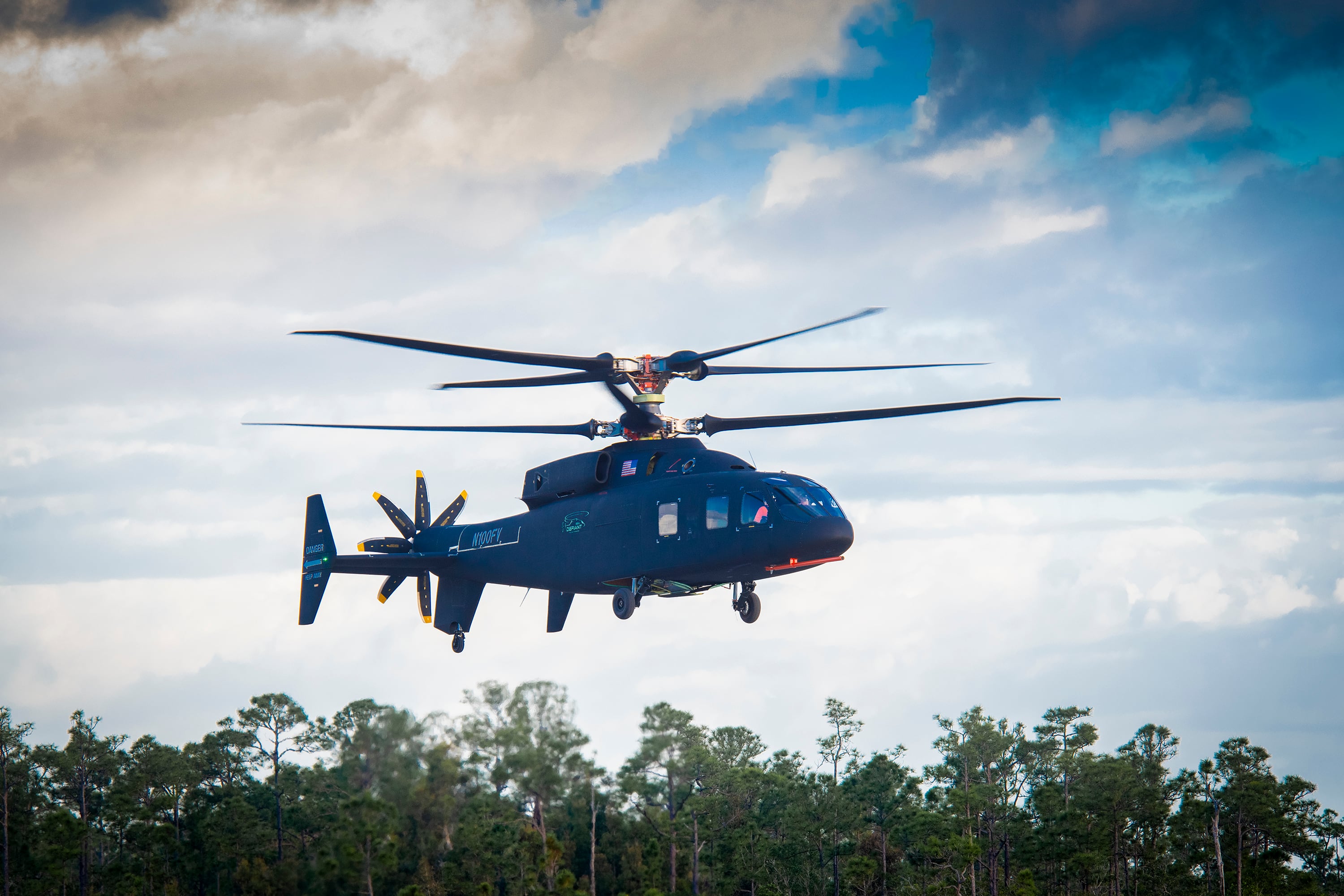Army Futures Command introduced about a dozen soldiers to technology demonstrators for the service’s future vertical lift program last week, giving them an opportunity to provide input prior to the evaluations and fly-offs over the next few years.
The soldiers spent a full day each with Bell’s V-280 Valor tilt-rotor aircraft in Arlington, Texas, and Sikorsky-Boeing’s SB-1 Defiant coaxial helicopter in West Palm Beach, Florida.
The site visits included flying simulators and aircraft familiarizations. Two of the soldiers who participated spoke with Army Times about the experience.
“We’ve never seen anything like it,” said Chief Warrant Officer 2 William Bogert, a UH-60 Black Hawk pilot with the 82nd Combat Aviation Brigade.
The speed and range offered by the FVL program could be the biggest game changers, he noted. The V-280, for instance, has an advertised cruising speed of 280 knots and a range of 800 nautical miles, which is nearly double that of the current utility and assault helicopters.
“We can be on a team sooner; we can get out of there faster,” Bogert said. “We can go places that we have never went before. So it just really allows us in Army aviation to expand our mission set and better support the ground force.”
The visits are known as “soldier touchpoints," but they usually come at a later stage in the acquisition process to test equipment, according to Sarah Tate, a spokeswoman for the Army’s FVL Cross Functional Team.
“What we’re trying to do is actually implement this into the provision process," Tate said. “Where they can help make decisions before we get to a finished product.”
The V-280 Valor and SB-1 Defiant are demonstrators that will inform the Army as it moves toward actually selecting vendors to produce and later buy new aircraft.
“Those are not going to become Army aircraft,” noted James Thomson, deputy director of Army Futures Command’s FVL cross functional team. “It’s the knowledge and the data points and the technology ... that will allow us to begin a procurement process for future aircraft.”
The aircraft aren’t necessarily technological leaps on their own, but instead combine technologies that have been maturing over the last couple decades, like advanced composite structures for lighter aircraft and advanced rotor control.
Putting all that technology together into one platform is what allows “a leap ahead in performance and capability," Thomson said.

The soldier touchpoints trip last week signals a shift in how the Army is thinking about acquisitions overall, Bogert said, adding that trips like this will ultimately cut down on superfluous or counter-intuitive designs that don’t work well for line pilots flying combat missions.
“Anyone who has been in it always had a piece of equipment that you just didn’t understand or didn’t make sense,” Bogert added. “And what this does to bring the end user into that design process.”
The Army aviators met with the engineers and test pilots working on the FVL programs and then went down to the technology demonstrators to offer what they saw as strengths and weaknesses for both aircraft, said Chief Warrant Officer 3 Shawn Huebner, an Apache pilot with the 82nd Combat Aviation Brigade.
“We were able to sit in the aircraft to see what it actually looks like," Huebner said. “We have a day-to-day operator view, and they were very interested in taking copious notes on our input, to hopefully implement what we said and to also give us an answer back to why they decided to make a move or design it the way they did.”
The aviators declined to discuss specifics but said that their advice to the two teams revolved around end-user issues like reducing pilot workload and maximizing comfort.
“You’re going to be sitting there for hours and hours on end,” Bogert said. “It helps with fatigue to keep the pilot comfortable.”
The aviators were also able to experience the simulators for both aircraft — a place where pilots spend a large chunk of time. Defense firms have test pilots who sit in those simulators and cockpits, but “they’re using it from a scientific point, not in an air assault standpoint,” Bogert noted.

“[We] just asked questions about why they designed things the way they did and let them know how we’re going to use it," he added. That helps to "identify possible problems ahead of time.”
Reduction of workload has also been a major focal point for the manufacturers, because it allows the pilot to be more involved in their mission.
“And more involved in being able to get a better reconnaissance view than trying to conduct reconnaissance while in a hostile environment where there may be ... issues flying, or having issues with visibility,” Huebner said. “So, reducing pilot workload is the best and most significant thing.”
Despite all the new equipment, the technology demonstrators and their accompanying simulators weren’t overly difficult for the aviators to get comfortable with.
“It’s easier for us to transition into as experience pilots,” Huebner added. “Didn’t take a long time to pick up on either system.”
The two technology demonstrators will inform what the Army is calling a Future Attack Reconnaissance Aircraft and a Future Long Range Assault Aircraft, which the Army wants to field in about 2028 and 2030, respectively.
“It’s really exciting for me to be able to specifically stand face-to-face with the man developing the aircraft,” Bogert said. “He asked me what I want, and then he ... gives us what we want. It gets us the most efficient, most convenient product.”
“They were completely open with us,” he added. “Let us crawl around it, touch it, feel it, and just give them our honest opinion. And it was nice to have them genuinely care.”
Kyle Rempfer was an editor and reporter who has covered combat operations, criminal cases, foreign military assistance and training accidents. Before entering journalism, Kyle served in U.S. Air Force Special Tactics and deployed in 2014 to Paktika Province, Afghanistan, and Baghdad, Iraq.




